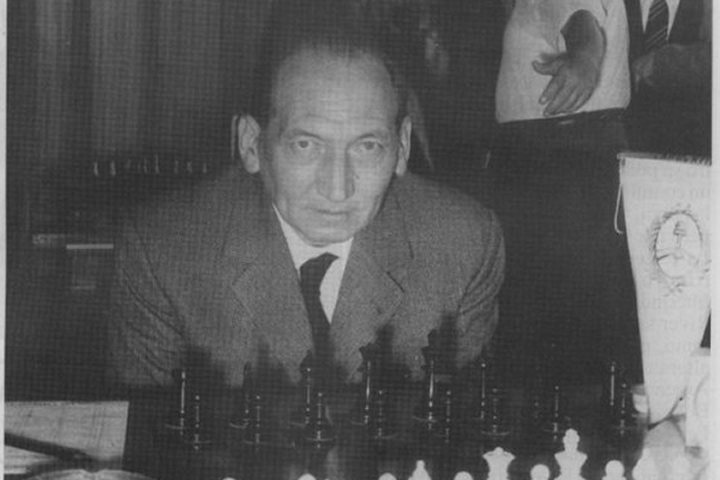


The name of Erich Eliskases has faded into the background in the consciousness of most chess fans, but Eliskases was one of the world's best players in the 1930s and was supposed to play for the World Championship in 1941.
Erich Eliskases was Austrian, born in Innsbruck on 15 February 1913 as the son of a tailor. His parents came from Bruneck, South Tyrol, which was awarded to Italy after the First World War. The name "Eliskases" is of Rhaeto-Romanic origin.
Eliskases only learned to play chess at the age of twelve, by chance:
"It was in the autumn of 1925 that I saw a pamphlet, entitled "Das Schachspiel" on display in a show-window; having heard something about this 'most difficult' game I made up my mind to buy the pamphlet. From the very start, I took such great interest in the game that I more or less dropped all my other favorite occupations. I studied by myself for a year without having any opponents other than my brother and a school-fellow, whom I defeated right along without any difficulty." (Fred Reinfeld, "Erich Eliskases", The Chess Review, 1/2 Jan/Feb 1934 p. 8-9)
In Carl Peter Wagner, a photographer, he found a strong mentor. Wagner was one of the best players in Innsbruck in the 1920s and had founded the Innsbruck Chess Society in 1926. Eliskases now met every afternoon from five o'clock to play chess with a chess friend of the Innsbruck SG in the Café Marx. Soon he was also attending the club evenings of the Innsbruck SC at Café Weiß and the Schlechter Chess Club at Café Clenk and made rapid progress in his playing strength. Eliskases became Tyrol Champion at the age of 15 and Austrian Champion at 16. He was called up to the Austrian national team for the first time at the age of 17, and at the 1930 Hamburg Chess Olympiad he was the youngest player in the tournament to play on the third board (11 out of 15, Austria came fourth).
After graduating from high school in 1931 Eliskases studied economics in Vienna for a year, but then decided to become a professional chess player and dropped out. In Vienna he had joined the SC Hietzing, where he competed with Ernst Grünfeld to become the best player in the club and then in Austria. After Eliskases had also defeated Rudolf Spielmann in several events in the following years, the ranking in Austrian chess was clear. Winning a major tournament also made you a grandmaster, though this was not yet an official title.
In addition to his tournament winnings, Eliskases later earned money as an editor of the Wiener Schachzeitung, but his work as an editor did not necessarily benefit his progress as a player. However, his analyses and annotations in the Wiener Schachzeitung were highly appreciated by the best players. In 1935 Eliskases helped Max Euwe to prepare for his world championship match against Alexander Alekhine. In 1937, Alekhine in turn invited the Austrian to be his training partner to prepare for the revanche match against Euwe. However, Eliskases got no more than a golden cigarette box as fee.
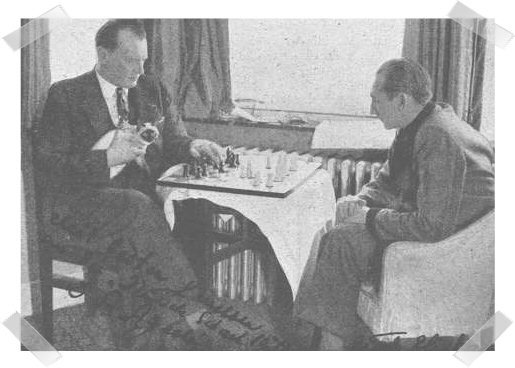
Alekhine and Eliskases
In the second half of the 1930s Eliskases had a series of tournament successes. He won in Zurich and Swinemünde in 1936, also in Noordwijk in 1938 (ahead of Paul Keres and Max Euwe), in Milan in 1939, in Bad Harzburg in 1939 and n Bad Elster ahead of Josef Lokvenc.

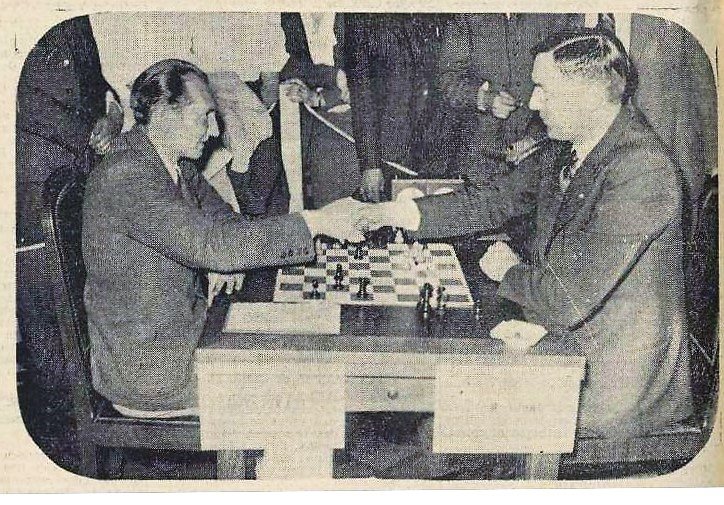
Eliskases and Euwe
Eliskases was absent from the 1931 Chess Olympiad (Prague) because he made his "Abitur" at that time. But at the Olympiads in 1933 (Folkstone) and 1935 (Warsaw) he took part again, but still played behind Grünfeld or Grünfeld and Spielmann. At the unofficial Chess Olympiad in Munich 1936, Eliskases represented Austria on the first board.
After the annexation of Austria to the German Reich in 1938, Eliskases took part in the Greater German Championships in 1938 and 1939 and won both competitions. During this period, Eliskases' successes placed him among the world's top chess players. The statistician Jeff Sonas sees Eliskases as the world's number nine in his subsequently calculated unofficial world ranking for the years 1938 to 1941.
After Eliskases had won a match against Efim Bogolyubov in 1939 (11.5-8.5, +6 =11 -3), World Champion Alexander Alekhine considered the Innsbruck native a worthy and possible challenger in a match for the World Championship. This, planned for 1941, did not come about, however, because Eliskases was already no longer in the German Reich at that time.
As the best player in Greater Germany, Eliskases played first board for Germany at the Chess Olympiad 1939 in Buenos Aires.

The German team with Friedl Rinder, who played in the Women's World Championship
During the Olympiad, Germany invaded Poland and the Second World War began. However, the Olympiad was played to a finish, though under difficult conditions. Germany won the gold medal but many European players did not return to war-torn Europe. All members of the Greater German Team - Eliskases, Ludwig Engels, Paul Michel, Albert Becker and Heinrich Reinhardt - also remained in South America.
With the many immigrant chess players, including Miguel Najdorf, the Argentine team became one of the best in the world after the end of the Second World War. Eliskases took part in four more Chess Olympiads for Argentina, and in 1964, in his last Olympiad, he even played on first board.
Eliskases had taken Argentine citizenship and had settled down in Cordoba in 1951. In 1954 he married Maria Esther Almedo, with whom he had a son, Carlos Enrico (born 1957). He gave lessons at an officer's school in Cordoba, and among his students was the young Henrique Mecking.
Eliskases also won a few tournaments in South America, including the tournament in Mar del Plata in 1948.
Two years later Eliskases was one of the participants in the Stockholm-Saltsjöbaden Interzonal Tournament, finishing tenth and missing out on a place in the Candidates' Tournament by two places. FIDE awarded Eliskases the title of International Master in 1950 and the title of Grandmaster in 1952. In 1955 he finished third in the Argentine National Championships behind Najdorf and Rossetto.
From time to time, Eliskases also played against his colleagues from the Greater German National Team, like Ludwig Engels, who had gone to Brazil.
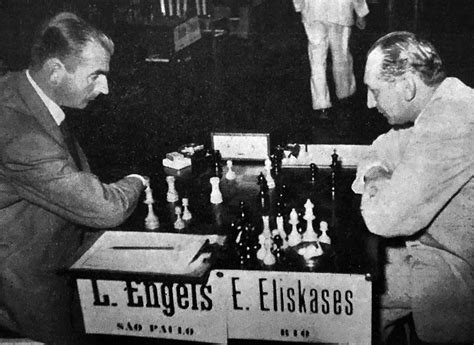
In the meantime, however, Eliskases played fewer and fewer tournaments outside South America and gradually lost contact with the world's top players. His last great success in Europe was second place in the 1959 Hoogovens tournament, then still held in Beverwijk, behind Olafsson and ahead of Donner, O'Kelly de Galway and Larsen.
The last surviving by Eliskases in the Mega Database is from 1976, when he played in the Arco Open.
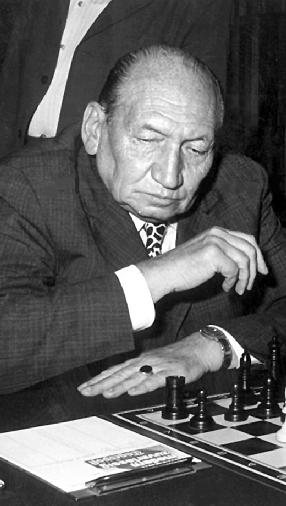 Tim Hagemann had a personal correspondence with Eliskases and shortly before his death in 1996 Eliskases sent him the manuscript of his textbook "Stellungsspiel" with his own games. The book had been published in Portuguese in Rio de Janeiro in 1943. Eliskases had also offered it in German to de Gruyter, but it was not accepted. Erich Eliskases left it to Tim Hagemann to do what he wanted with it.
Tim Hagemann had a personal correspondence with Eliskases and shortly before his death in 1996 Eliskases sent him the manuscript of his textbook "Stellungsspiel" with his own games. The book had been published in Portuguese in Rio de Janeiro in 1943. Eliskases had also offered it in German to de Gruyter, but it was not accepted. Erich Eliskases left it to Tim Hagemann to do what he wanted with it.
Hagemann had the manuscript published in 2000 by Caissa Publishing House, Kecskemet, Hungary. Hagemann writes:
"Stellungsspiel", the work of a world championship aspirant, is a forgotten jewel of chess literature. The manuscript was completed in 1941, but at that time only a Portuguese version adapted to the Brazilian market - Eliskases had been living in South America since 1939 - could be published. Half a year before his death, Eliskases gave me the old original manuscript, and I immediately realised that it had to be published, even after such a long time. Although there are now several valuable treatises on the subject, "Stellungsspiel" has the quality and dignity of a classic of chess literature. No less a person than Lasker praised Eliskases as making the best game annotations. Positional play ... was his life's work. In the last months of his life, despite increasing physical weakness, Eliskases went through his book once more, deleting opening sections that had become obsolete and refining his already thorough endgame analyses.
In their book "Vergessene Meister: ein Lehr- und Lesebuch mit den besten Partien von Leonhardt, Rotlewi, Sultan Khan, Petrow und Eliskases. (Schachverlag Kania, Eberdingen 2018) the authors Frank Zeller and Tim Hagemann dedicated one of the chapters to Eliskases.
Eliskases died 2 February 1997 in Cordoba.
| Advertising |